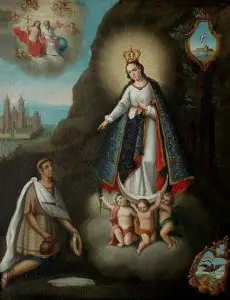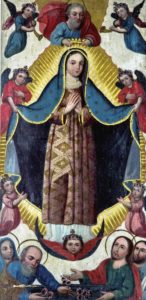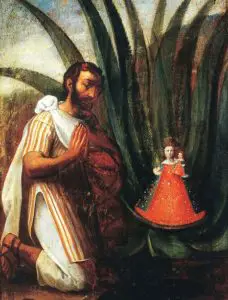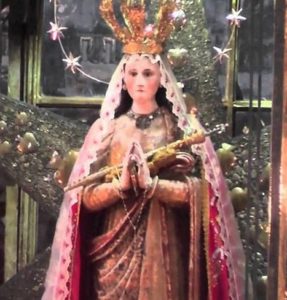Podcast: Play in new window | Download
Subscribe: Apple Podcasts | RSS
This is the third part in a series about little-known Virgin Mary images in Mexico. It would be an understatement to declare that religion is a vital part of the lives of most Mexicans. The modern country of Mexico is overwhelmingly Catholic, but some of its beliefs and rituals have foundations in its timeless indigenous past. As in other predominantly Catholic countries, the Virgin Mary, the earthly mother Jesus, plays an important role in the religious lives of Mexicans. Many different apparitions or aspects of the Virgin Mary in Mexico and many shrines devoted to her are known to many people outside the country. In fact, one of the largest religious pilgrimage sites in the entire world can be found in the heart of Mexico itself, in Mexico City, on a hill called Tepeyac. While many millions of visitors from dozens of countries make the pilgrimage to the shrine of the Virgin of Guadalupe every year, there are many smaller shrines and Marian devotions not well-known outside of Mexico or even outside their respective regions within Mexico. Here are three.
- The Virgin of Ocotlán, Tlaxcala
 Not even ten years after the appearance of the Virgin of Guadalupe to Juan Diego on Tepeyac Hill, another Juan Diego – but this one from Tlaxcala – had his own encounter with a powerful feminine divine presence. The apparition took place in the Ocotlán region just outside Tlaxcala City. It was the spring of 1541, and Juan Diego Bernardino was crossing a dense forest of pine trees, when a bright light appeared and out of the light walked the Virgin Mary. In Juan Diego Bernardino’s language, Nahuatl, the Virgin kindly asked him where he was going. Juan Diego replied that he was bringing water for the sick people of his village who would die without remedy due to a terrible epidemic. The Virgin said to him softly: “Come follow me, I will give you water from another source that will extinguish the contagion, and heal not only your relatives but will make healthier any who drink of it.” The Virgin raised her hand and a bubbling spring of fresh water appeared, coming out of the ground a few feet from them. Juan Diego filled his jug with this fresh spring water and went to Xiloxoxtla, his hometown. Before he left that hallowed spot in the forest, the heavenly lady ordered Juan Diego to communicate what had happened to the Franciscans, indicating that if they came to the forest, they would find an image of her inside a piece of pine wood that should be given to the Church of San Lorenzo. At dusk the friars went to the spot that Juan Diego had indicated, and they saw the forest was on fire, but with flames that did not consume. There was a large tree that radiated special light, they pointed it out and the next day seeing that it was hollow, they hacked it open, finding inside the sculpture of the Virgin Mary that today is on the main altar at the renamed Basilica of Ocotlán. The statue stands upright, almost 5 feet tall, with hands in prayer and wearing a tunic and mantle. The tunic is red with gold trim and the mantle was once blue, but the color has since faded a great deal. Over the years the Virgin has worn many different cloth capes. She now wears a crown which has taken many forms since the statue’s canonical coronation by Pope Pius the Tenth in 1909. According to the locals, the Virgin’s face changes color between red and pale, depending on the stages of the Christian calendar or because of events that society experiences. There are eyewitness testimonies of those who have seen her sweat. As the patroness and protector of both the Mexican states of Tlaxcala and Puebla, many people over nearly 500 years have ascribed countless miracles to the Virgin of Ocotlán.
Not even ten years after the appearance of the Virgin of Guadalupe to Juan Diego on Tepeyac Hill, another Juan Diego – but this one from Tlaxcala – had his own encounter with a powerful feminine divine presence. The apparition took place in the Ocotlán region just outside Tlaxcala City. It was the spring of 1541, and Juan Diego Bernardino was crossing a dense forest of pine trees, when a bright light appeared and out of the light walked the Virgin Mary. In Juan Diego Bernardino’s language, Nahuatl, the Virgin kindly asked him where he was going. Juan Diego replied that he was bringing water for the sick people of his village who would die without remedy due to a terrible epidemic. The Virgin said to him softly: “Come follow me, I will give you water from another source that will extinguish the contagion, and heal not only your relatives but will make healthier any who drink of it.” The Virgin raised her hand and a bubbling spring of fresh water appeared, coming out of the ground a few feet from them. Juan Diego filled his jug with this fresh spring water and went to Xiloxoxtla, his hometown. Before he left that hallowed spot in the forest, the heavenly lady ordered Juan Diego to communicate what had happened to the Franciscans, indicating that if they came to the forest, they would find an image of her inside a piece of pine wood that should be given to the Church of San Lorenzo. At dusk the friars went to the spot that Juan Diego had indicated, and they saw the forest was on fire, but with flames that did not consume. There was a large tree that radiated special light, they pointed it out and the next day seeing that it was hollow, they hacked it open, finding inside the sculpture of the Virgin Mary that today is on the main altar at the renamed Basilica of Ocotlán. The statue stands upright, almost 5 feet tall, with hands in prayer and wearing a tunic and mantle. The tunic is red with gold trim and the mantle was once blue, but the color has since faded a great deal. Over the years the Virgin has worn many different cloth capes. She now wears a crown which has taken many forms since the statue’s canonical coronation by Pope Pius the Tenth in 1909. According to the locals, the Virgin’s face changes color between red and pale, depending on the stages of the Christian calendar or because of events that society experiences. There are eyewitness testimonies of those who have seen her sweat. As the patroness and protector of both the Mexican states of Tlaxcala and Puebla, many people over nearly 500 years have ascribed countless miracles to the Virgin of Ocotlán.
- The Virgin of Tecaxic
Located in the state of México just west of Mexico City, the small town of Tacaxic was once a large city in the times before the Conquest. In the indigenous language Nahuatl, “Tecaxic” means “stone vessel” and the area had been under Aztec control for centuries. By the mid-1500s an epidemic devastated the population of Tecaxic in such a way that only two neighbors remained in the town. Overwhelmed by sadness and loneliness, they soon left the town, which thus came to be deserted.
 With the exodus of the two survivors, a chapel that townsfolk had built in prosperous times on a hill called El Molcajete was abandoned. In this humble religious site, they venerated an image of Our Lady of the Assumption, painted in tempera on an Indian canvas. Left alone, the chapel slowly succumbed to the elements. First came a leaky roof, then cracks in the walls and floors. The chapel was in such a sorry state when a Spanish gentleman from Mexico City named Antonio de Sámano y Ledezma happened to pass through Tecaxic. Don Antonio took refuge in that place when a very heavy rainstorm began. It did not matter, though, because inside the structure the Spanish gentleman got as wet as outside. He noticed that the water leaking into the chapel ran over the image of the Virgin Mary, and it was a miracle to him that the beautiful painting had not completely faded. In fact, this unique piece of art seemed to give off its own luminescence that filled the entire room.
With the exodus of the two survivors, a chapel that townsfolk had built in prosperous times on a hill called El Molcajete was abandoned. In this humble religious site, they venerated an image of Our Lady of the Assumption, painted in tempera on an Indian canvas. Left alone, the chapel slowly succumbed to the elements. First came a leaky roof, then cracks in the walls and floors. The chapel was in such a sorry state when a Spanish gentleman from Mexico City named Antonio de Sámano y Ledezma happened to pass through Tecaxic. Don Antonio took refuge in that place when a very heavy rainstorm began. It did not matter, though, because inside the structure the Spanish gentleman got as wet as outside. He noticed that the water leaking into the chapel ran over the image of the Virgin Mary, and it was a miracle to him that the beautiful painting had not completely faded. In fact, this unique piece of art seemed to give off its own luminescence that filled the entire room.
A few years later two men from Toluca challenged each other to a fight because of a dispute over a woman. They chose the back of the abandoned chapel as their fight’s location. The two men were well into their scuffle when they heard a type of music they had never heard before, as if it had come from heaven. Amazed, they suspended the fight and walked toward the chapel, which was where the music was coming from. When they opened the dilapidated door of this run-down building the music intensified, and then they saw three chubby angels flying around the holy image of the Virgin Mary which was uncorrupt and giving off a bright light. The two enemies vowed to stop fighting and ceased to be enemies making a solemn promise in front of this heavenly scene. A convent in nearby Toluca would later confirm that every Saturday of the year, heavenly music was heard in that abandoned chapel. Many other travelers and random passers-by who went near the ruins of the chapel would also report bright lights, beautiful music and sightings of happy, chubby angels flying overhead.
Because of these reports, Father José Gutiérrez, who oversaw the Toluca parish, encouraged the residents of Toluca and the farmers of Ixtlahuaca to erect a new and much larger chapel to house the sacred image of Our Lady of the Assumption. After some false starts, the priest’s wishes were fulfilled. The Sanctuary of Our Lady of Tecaxic was completed in 1655. Today the Sanctuary is abandoned, falling into disrepair sometime in the early 1800s. Absent are the numerous pilgrims that used to visit this holy place. The few people who remain in the area in and around Tecaxic are praying for a new sanctuary to be built to honor this great lady.
- La Virgen de los Remedios, Naucalpan
Known as the Virgin of the Remedies in English, this wooden statue of the Virgin Mary stands ten and a half inches tall, and legend tells us that it was made somewhere on the Iberian Peninsula sometime around the year 800 AD. It ended up in a chapel in Alcántara, Extremadura in what is now western Spain near the modern-day border with Portugal. In the early 1500s, the priest overseeing that church in Alcántara gave the Virgin to a soldier from Extremadura who was to leave for a war in Italy.
 When this soldier returned from the war to his hometown, he learned that his brother Juan Rodríguez de Villafuerte enlisted to be part of the army of Cortés to take part in the conquest of new lands in the New World. He advised him to bring with him that Virgin, telling him that she had not only given him good fortune, but had also remedied his wounds, hence the name, La Virgen de los Remedios. Villafuerte arrived at the Aztec capital of Tenochtitlán alongside Cortés and after the famous conquistador ordered the removal of the Aztec gods from the Templo Mayor, Rodríguez de Villafuerte placed the Spanish virgin in Huitzilopochtli’s place. On June 30, 1520, known as La Noche Triste, or “The Sad Night,” Villafuerte rescued the old Spanish statue before fleeing Tenochtitlán with his companions. According to the chroniclers, Rodríguez de Villafuerte preferred to carry his Virgin than make off with Aztec gold. This may have saved his life, as many of his companions, overladen with weighty gold, did not make it to safety in time. Villafuerte and others made it to the town of Naucalpan and hid the statue in the hollow of a maguey plant on a hill now known as Cerro de los Remedios which was then called Otomcopolco, which means “place of Otomí people.” As an interesting aside, on this hill stood the ruins of a pre-Aztec astronomical observatory. The Virgin was not located until 20 years later by the Otomí King named Cecuauhtli, who after baptism was known as Juan del Águila Tovar. The Otomí king took the statue to his home, but according to the legend the Virgin returned again and again to the place where the king found it. So, it was on that very spot on the hill where Villafuerte originally hid the statue where religious authorities built a chapel to honor the Virgin of the Remedies. Within a few decades the chapel was in a horrible state, so by the early 1570s it was decided that the Virgin would get a new home. Both the viceroy of New Spain, Martín Enríquez de Almaza y Ulloa, and the archbishop of Mexico, Pedro Moya Contreras, agreed to carry out the project jointly. The viceroy paid for it, and the archbishop was satisfied to be able to bless the work when it was finished. Construction on the sanctuary began in 1574 and concluded at the end of August 1575.
When this soldier returned from the war to his hometown, he learned that his brother Juan Rodríguez de Villafuerte enlisted to be part of the army of Cortés to take part in the conquest of new lands in the New World. He advised him to bring with him that Virgin, telling him that she had not only given him good fortune, but had also remedied his wounds, hence the name, La Virgen de los Remedios. Villafuerte arrived at the Aztec capital of Tenochtitlán alongside Cortés and after the famous conquistador ordered the removal of the Aztec gods from the Templo Mayor, Rodríguez de Villafuerte placed the Spanish virgin in Huitzilopochtli’s place. On June 30, 1520, known as La Noche Triste, or “The Sad Night,” Villafuerte rescued the old Spanish statue before fleeing Tenochtitlán with his companions. According to the chroniclers, Rodríguez de Villafuerte preferred to carry his Virgin than make off with Aztec gold. This may have saved his life, as many of his companions, overladen with weighty gold, did not make it to safety in time. Villafuerte and others made it to the town of Naucalpan and hid the statue in the hollow of a maguey plant on a hill now known as Cerro de los Remedios which was then called Otomcopolco, which means “place of Otomí people.” As an interesting aside, on this hill stood the ruins of a pre-Aztec astronomical observatory. The Virgin was not located until 20 years later by the Otomí King named Cecuauhtli, who after baptism was known as Juan del Águila Tovar. The Otomí king took the statue to his home, but according to the legend the Virgin returned again and again to the place where the king found it. So, it was on that very spot on the hill where Villafuerte originally hid the statue where religious authorities built a chapel to honor the Virgin of the Remedies. Within a few decades the chapel was in a horrible state, so by the early 1570s it was decided that the Virgin would get a new home. Both the viceroy of New Spain, Martín Enríquez de Almaza y Ulloa, and the archbishop of Mexico, Pedro Moya Contreras, agreed to carry out the project jointly. The viceroy paid for it, and the archbishop was satisfied to be able to bless the work when it was finished. Construction on the sanctuary began in 1574 and concluded at the end of August 1575.
 More than half a century later, on March 25, 1629, the construction of the towers began with their dome and transept, and the application of beautiful plaster ornaments. Before the many transformations it underwent, the sanctuary had a main house to accommodate the poor and pilgrims, and rooms for viceroys, archbishops, judges, inquisitors, principal persons and special guests. The statue of the Virgin of the Remedies remained in the Naucalpan chapel for only a few decades until it was transferred to the Mexico City Cathedral. She returned to Naucalpan in 1810 at the beginning of the Mexican War of Independence. It was here where this very European religious image was declared patroness of the Spanish military and dressed in a military uniform. This was a political move to counter Father Hidalgo’s use of the Virgin of Guadalupe to symbolize the resistance against colonialism. For more information about the Virgin of Guadalupe, please see Mexico Unexplained episode number 3. In 1938, the government of Mexico under President Lázaro Cárdenas declared 990 acres around the shrine the Los Remedios National Park. Today the sanctuary is visited by many thousands of people from Mexico and the rest of the world.
More than half a century later, on March 25, 1629, the construction of the towers began with their dome and transept, and the application of beautiful plaster ornaments. Before the many transformations it underwent, the sanctuary had a main house to accommodate the poor and pilgrims, and rooms for viceroys, archbishops, judges, inquisitors, principal persons and special guests. The statue of the Virgin of the Remedies remained in the Naucalpan chapel for only a few decades until it was transferred to the Mexico City Cathedral. She returned to Naucalpan in 1810 at the beginning of the Mexican War of Independence. It was here where this very European religious image was declared patroness of the Spanish military and dressed in a military uniform. This was a political move to counter Father Hidalgo’s use of the Virgin of Guadalupe to symbolize the resistance against colonialism. For more information about the Virgin of Guadalupe, please see Mexico Unexplained episode number 3. In 1938, the government of Mexico under President Lázaro Cárdenas declared 990 acres around the shrine the Los Remedios National Park. Today the sanctuary is visited by many thousands of people from Mexico and the rest of the world.
